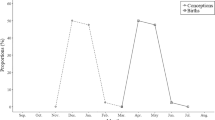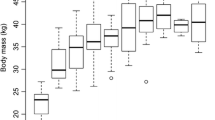Abstract
We examined the relationships between family (female parentage), body size of females, brood retention time between mating and parturition, female fecundity, and early growth of offspring in the guppy Poecilia reticulata. Mature, virgin females from a single brood were mated with a single male. Results of generalized linear models indicate that the effect of the family on female fecundity and offspring growth was significant, which suggested that these traits are genetically determined to a certain extent. Larger females at the time of mating produced larger broods, although female body size at the time of parturition did not affect brood size, in contrast to the results of some previous studies in guppies. Brood size was negatively associated with the body size of neonates. Results highlighted significant associations between brood retention time and female fecundity as well as offspring growth. In addition, the interaction between the family and brood retention time was significantly associated with female fecundity and offspring growth. Females of some families had longer retention times of larger broods, whereas those of other families had shorter retention times of smaller broods. On the other hand, females with longer brood retention times produced smaller neonates with slower growth. Since the family also affected the brood retention time, selection may work against the duration of brood retention of females via the size, growth and number of offspring, depending on environmental factors such as the intensity of predation or competition in neonates.





Similar content being viewed by others
References
Abrams PA, Leimar O, Nylin S, Wiklund C (1996) The effect of flexible growth rates on optimal sizes and development times in a seasonal environment. Am Nat 147:381–395
Arendt JD, Wilson DS (1997) Optimistic growth: competition and an ontogenic niche-shift select for rapid growth in pumpkinseed sunfish (Lepomis gibbosus). Evolution 51:1946–1954
Barbosa M, Magurran AE (2010) Guppies control offspring size at birth in response to differences in population sex ratio. Biol J Linn Soc 100:414–419
Barbosa M, Dornelas M, Magurran AE (2010) Effects of polyandry on male phenotypic diversity. J Evol Biol 23:2442–2452
Bashey F (2006) Cross-generational environmental effects and the evolution of offspring size in the Trinidadian guppy Poecilia reticulata. Evolution 60:348–361
Bashey F (2008) Competition as a selective mechanism for larger offspring size in guppies. Oikos 117:104–113
Bell MA, Foster SA (1994) The evolutionary biology of the threespine stickleback. Oxford University Press, Oxford
Breden F, Novinger D, Schubert A (1995) The effect of experience on mate choice in the Trinidad guppy, Poecilia reticulata. Environ Biol Fish 42:323–328
Dzikowski R, Hulata G, Harpaz S, Karplus I (2004) Inducible reproductive plasticity of the guppy Poecilia reticulata in response to predation cues. J Exp Zool 301A:776–782
Evans JP, Magurran AE (2000) Multiple benefits of multiple mating in guppies. Proc Natl Acad Sci USA 97:10074–10076
Evans JP, Gasparini C, Pilastro A (2007) Female guppies shorten brood retention in response to predator cues. Behav Ecol Sociobiol 61:719–727
Houde AE (1997) Sex, color, and mate choice in guppies. Princeton University Press, Princeton
Jonsson N, Jonsson B (1999) Trade-off between egg mass and egg number in brown trout. J Fish Biol 55:767–783
Karino K, Haijima Y (2004) Algal-diet enhances sexual ornament, growth and reproduction in the guppy. Behaviour 141:585–601
Karino K, Sato A (2009) Male-biased sex ratios in offspring of attractive males in the guppy. Ethology 115:682–690
Karino K, Shimada Y, Kudo H, Sato A (2010) Relative importance of the area and intensity of the orange spots of male guppies Poecilia reticulata as mating traits preferred by females. J Fish Biol 77:299–307
Liley NR (1966) Ethological isolating mechanisms in four sympatric species of poeciliid fishes. Behaviour 13:1–197
Lynch M, Walsh B (1998) Genetics and analysis of quantitative traits. Sinauer Associates, Sunderland
Magurran AE (2005) Evolutionary ecology: the Trinidadian guppy. Oxford University Press, Oxford
Marsh-Matthews E, Deaton R (2006) Resources and offspring provisioning: a test of the Trexler–DeAngelis model for matrotrophy evolution. Ecology 87:3014–3020
Marsh-Matthews E, Brooks M, Deaton R, Tan H (2005) Effects of maternal and embryo characteristics on post-fertilization provisioning in fishes of the genus Gambusia. Oecologia 144:12–24
Ojanguren AF, Evans JP, Magurran AE (2005) Multiple mating influences offspring size in guppies. J Fish Biol 67:1184–1188
Pilastro A, Bisazza A (1999) Insemination efficiency of two alternative male mating tactics in the guppy (Poecilia reticulata). Proc R Soc Lond B 266:1887–1891
Pilastro A, Mandelli M, Gasparini C, Dadda M, Bisazza A (2007) Copulation duration, insemination efficiency and male attractiveness in guppies. Anim Behav 74:321–328
Potts GW, Wootton RJ (1984) Fish reproduction: strategies and tactics. Academic, London
Reynolds JD, Gross MR (1992) Female mate preference enhances offspring growth and reproduction in a fish, Poecilia reticulata. Proc R Soc Lond B 250:57–62
Reznick D (1983) The structure of guppy life histories: the tradeoff between growth and reproduction. Ecology 64:862–873
Reznick DN (1991) Maternal effects in fish life histories. In: Dudley E (ed) Evolutionary biology. Discorides, Portland, pp 780–793
Reznick DN, Bryga H (1987) Life-history evolution in guppies (Poecilia reticulata). 1. Phenotypic and genetic changes in an introduction experiment. Evolution 41:1370–1385
Reznick DN, Miles DB (1989) Review of life history patterns in poeciliid fishes. In: Meffe GK, Snelson FF (eds) Ecology and evolution of livebearing fishes. Prentice Hall, Upper Saddle River, pp 125–148
Reznick D, Yang AP (1993) The influence of fluctuating resources on life history: patterns of allocation and plasticity in female guppies. Ecology 74:2011–2019
Reznick DA, Bryga H, Endler JA (1990) Experimentally induced life-history evolution in a natural population. Nature 346:357–359
Ridley M (1996) Evolution, 2nd edn. Blackwell, Oxford
Roff DA (2002) Life history evolution. Sinauer Associates, Sunderland
Sato A, Karino K (2010) Female control of offspring sex ratios based on male attractiveness in the guppy. Ethology 116:524–534
Sato A, Shimoichi A, Karino K (2011) Copulation type affects parturition in the guppy. Zool Sci 28:98–104
Shine R, Downes SJ (1999) Can pregnant lizards adjust their offspring phenotypes to environmental conditions? Oecologia 119:1–8
Shine R, Olsson M (2003) When to be born? Prolonged pregnancy or incubation enhances locomotor performance in neonatal lizards (Scincidae). J Evol Biol 16:823–832
Smith CC, Fretwell SD (1974) The optimal balance between size and number of offspring. Am Nat 108:499–506
Stearns SC (1992) The evolution of life histories. Oxford University Press, Oxford
Travis J (1989) Ecological genetics of life history traits in poeciliid fishes. In: Meffe GK, Snelson FF (eds) Ecology and evolution of livebearing fishes. Prentice Hall, Oxford, pp 185–200
Walsh MR, Reznick DN (2009) Phenotypic diversification across an environmental gradient: a role for predators and resource availability on the evolution of life histories. Evolution 63:3201–3213
Watt PJ, Shohet AJ, Renshaw K (2001) Female choice for good genes and sex-biased broods in guppies. J Fish Biol 59:843–850
Wootton RJ (1998) Ecology of teleost fishes, 2nd edn. Kluwer, Dordrecht
Wourms JP (1981) Viviparity: the maternal–fetal relationship in fishes. Amer Zool 21:473–515
Acknowledgments
We are grateful to the two reviewers for their valuable comments on early version of the manuscript, and to Aya Sato for the help with the experiments. This study was partly supported by a Grant-in-Aid for Scientific Research (#19570015) to KK from the Japan Society for the Promotion of Science. This work complied with the current laws of Japan.
Author information
Authors and Affiliations
Corresponding author
About this article
Cite this article
Karino, K., Ikeuchi, M. Female fecundity and early offspring growth in the guppy, Poecilia reticulata . Ichthyol Res 58, 255–262 (2011). https://doi.org/10.1007/s10228-011-0222-6
Received:
Revised:
Accepted:
Published:
Issue Date:
DOI: https://doi.org/10.1007/s10228-011-0222-6




